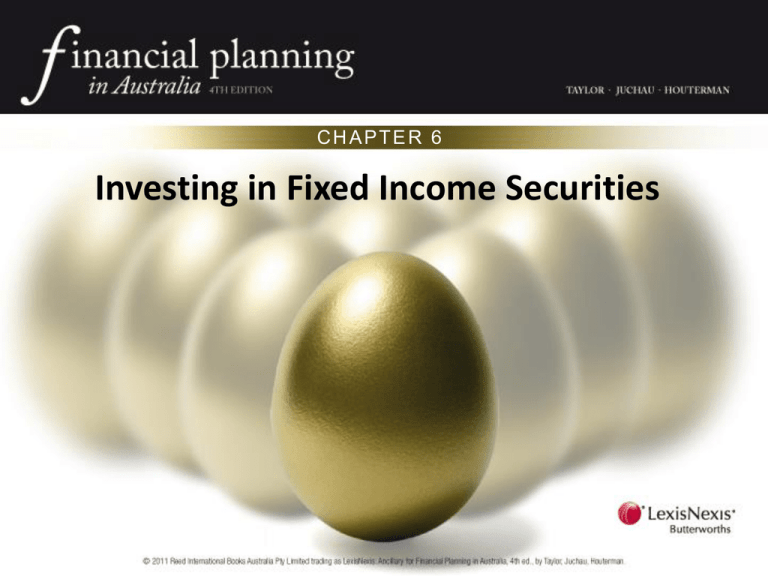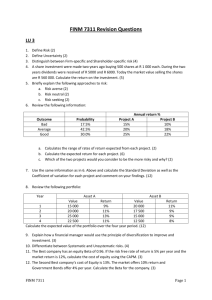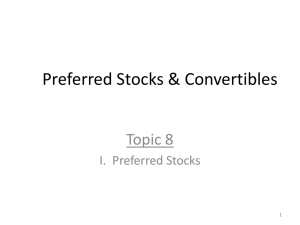Investing in Fixed Income Securities Powerpoint Lexis Nexis
advertisement

CHAPTER 6
Investing in Fixed Income Securities
OVERVIEW
• Fixed income securities represent borrowing by
governments and corporations
• Ratings agencies assess the quality of various offerings
• Investing in fixed income securities involves some risk
• Prices of fixed income securities depend on the terms of
the security and prevailing interest rates
Fixed Income Securities
• Fixed income securities are a group of
investment products that offer a fixed
periodic return
• Some forms offer contractually
guaranteed returns while others have
specified, but not guaranteed, returns.
• Because of their fixed returns, fixed
income securities tend to be popular
investments during periods of high
interest rates when investors seek to lock
in high returns
Fixed Income Securities
The main forms of fixed income securities
are:
• Bonds
• Hybrids, which have characteristics of
both bonds and shares
— preference shares, and
— convertible securities
Characteristics of Bonds
• Bonds are the long-term debt
instruments (that is, IOUs) of corporations
and governments that offer a fixed
periodic return.
• A bondholder has a contractual right to
receive a fixed interest return (known as
the coupon rate) plus the return of the
bond’s face value (the stated value given
on the certificate) at maturity (typically
three to 10 years).
• Long-term debt instruments issued by
corporations (the Corporate Bond Market)
can be classified as debentures or
unsecured notes.
Characteristics of Bonds
• Coupon payments are generally made
semi-annually
• Once a bond is issued it can (usually) be
traded in what is called the secondary
market
• As interest rates change, the price of the
bond changes, but in the opposite
direction
Types of Bonds
• Main issuers
— Commonwealth Government;
Commonwealth Government
Securities (CGS) mainly Treasury
Bonds
• Fixed coupon
• Capital indexed
— Semi-government; state
government authorities
— Corporate; debentures and
unsecured notes
Yields
• The yield or internal rate of return of an
investment is the compounded annual
rate of return earned. It can also be
viewed as the discount rate that produces
a present value of benefits from the
investment just equal to the cost of the
investment.
• The current interest rate for a bond
compared with its market value is known
as the running yield on the bond.
Yields
• The total return from a bond over the
whole of its remaining term, including
both interest payments and capital gains
or losses, is known as the yield to
maturity (YTM).
• The term ‘yield’, used alone, usually
refers to the yield to maturity.
Bond Ratings
• Both Moody’s and Standard and Poor’s
(S&P) have ratings for the various bonds
and preference shares on issue
• Both agencies have 9 categories, which
are equivalent
— Moodys: Aaa, Aa, A to Caa, Ca, C
— S & P: AAA, AA, A to CCC, CC, C
Bond Risks
• Interest rate risk; values decline when
interest rates rise
• Credit risk; the borrower might default
on repayment
• Inflation risk; the real value of fixed
interest payments may decline
• Liquidity risk; buyers might not be
present on the secondary market when a
sale is desired
Bond Risks
• Interest rate risk; values decline when
interest rates rise
• Credit risk; the borrower might default
on repayment
• Inflation risk; the real value of fixed
interest payments may decline
• Liquidity risk; buyers might not be
present on the secondary market when a
sale is desired
Calculating Bond Prices
• Bond prices are calculated as the
Present Value of the sum of the future
interest payments and the redemption
value at maturity
• PV = FV / (1+i)n
PV is present value
FV is future value
i is the interest rate required
n is the term
Calculating Bond Prices
A single formula includes all these
individual present value calculations that
otherwise would need to be added
together
Price = C/i x {1-1/(1+i)n}+F/(1+i)n
C = Coupon value
F = Face value
Preference Shares
• Like ordinary shares, preference shares
represent an ownership interest in a
corporation and are a form of equity
funding, though they have a number of
features in common with debt. Like
ordinary shares, preference shares
represent an ownership interest in a
corporation.
• Like debt securities, and unlike ordinary
shares, preference shares have a stated
dividend rate and payment of this
dividend is given preference over other
share dividends of the same firm.
Preference Shares
• Preference shares have no maturity
date and holders of preference shares
often have no voting rights.
• Preference shares are typically issued by
companies which need money but don’t
want to issue debt to get it.
• Investors typically purchase them for
the dividends they pay, but preference
shares may also provide capital gains.
• Companies like to issue preference
shares because they don’t count as
ordinary shares and so don’t affect
earnings per share.
Convertible Securities
• Either a convertible note or a
convertible preference share
• Key feature is that under stated
conditions the convertible note or the
convertible preference share can be
‘converted’ to ordinary shares
• The strategy is to invest in these more
defensive assets when market conditions
are unfavourable, and then covert to
ordinary shares when the share market is
expected to rise
Summary
This chapter has covered:
• Characteristics of bonds and the
markets in which they are traded
• The rating of bonds by the ratings
agencies
• The risks involved in bond investment
• The calculation of bond prices, given the
yield required
• Some types of hybrid securities






